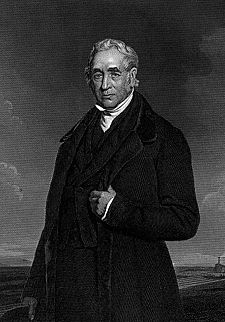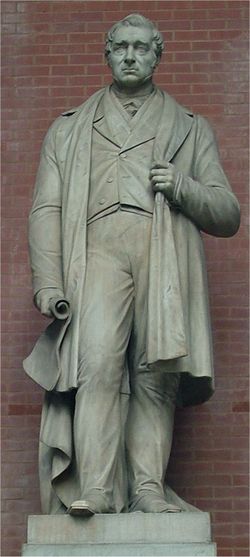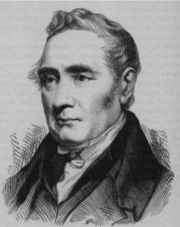George Stephenson
2008/9 Schools Wikipedia Selection. Related subjects: Engineers and inventors
| George Stephenson | |
 Mechanical Engineer and Inventor
|
|
| Born | June 9, 1781 Wylam, Northumberland, England |
|---|---|
| Died | August 12, 1848 Tapton House, Chesterfield, Derbyshire, England |
George Stephenson ( 9 June 1781 – 12 August 1848) was an English mechanical engineer who built the first public railway line in the world to use steam locomotives and is known as the "Father of Railways". The Victorians considered him a great example of diligent application and thirst for improvement, with self-help advocate Samuel Smiles particularly praising his achievements. His rail gauge of 4 ft 8½ in (1435 mm), sometimes called "Stephenson gauge", is the world's standard gauge.
Early life
George Stephenson was born in Wylam, Northumberland, 9.3 miles (15.0 km) west of Newcastle upon Tyne. He was the second child of Robert and Mabel, neither of whom could read or write. Robert was the fireman for Wylam Colliery pumping engine, earning a low wage, so that there was no money for schooling. At 17, Stephenson became an engineman at a local colliery. George realised the value of education and paid to study at night school to learn reading, writing and arithmetic. In 1801 he began work at Black Callerton colliery as a ‘brakesman’, controlling the winding gear of the pit. In 1802 he married Frances (Fanny) Henderson and moved to Willington Quay, east of Newcastle. There he worked as a brakesman while they lived in one room of a cottage. George made shoes and mended clocks to supplement his income. In 1803 their son Robert was born, and in 1804 they moved to West Moor, near Killingworth while George worked as a brakesman at Killingworth pit. His wife gave birth to a daughter, who died after a few weeks, and in 1806 Fanny died of consumption. George, then decided to find work in Scotland, and he left Robert with a local woman while he went to work in Montrose. After a few months he returned, probably because his father was blinded in a mining accident. George moved back into his cottage at West Moor and his unmarried sister Eleanor moved in to look after Robert. In 1811 the pumping engine at High Pit, Killingworth was not working properly and Stephenson offered to fix it. He did so with such success that he was soon promoted to enginewright for the neighbouring collieries at Killingworth, responsible to maintaining and repairing all of the colliery engines. He soon became an expert in steam-driven machinery.

The miners' safety lamp
In 1818, aware of the explosions often caused in mines by naked flames, Stephenson began to experiment with a safety lamp that would burn without causing an explosion. At the same time, Sir Humphry Davy, the eminent scientist was looking at the problem himself. Despite his lack of any scientific knowledge, Stephenson, by trial and error, devised a lamp in which the air entered via tiny holes. Stephenson demonstrated the lamp himself to two witnesses by taking it down Killingworth colliery and holding it directly in front of a fissure from which fire damp was issuing. This was a month before Davy presented his design to the Royal Society. The two designs differed in that, the Davy’s lamp was surrounded by a screen of gauze, whereas Stephenson’s lamp was contained in a glass cylinder. For his invention Davy was awarded £2,000, whilst Stephenson was accused of stealing the idea from Davy. A local committee of enquiry exonerated Stephenson, proved that he had been working separately and awarded him £1,000 but Davy and his supporters refused to accept this. They could not see how an uneducated man such as Stephenson could come up with the solution that he had. In 1833 a House of Commons committee found that Stephenson had equal claim to having invented the safety lamp. Davy went to his grave believing that Stephenson had stolen his idea. The Stephenson lamp was used exclusively in the North East, whereas the Davy lamp was used everywhere else. The experience with Davy gave Stephenson a life-long distrust of London-based, theoretical, scientific experts.
Early locomotives
Richard Trevithick is credited with building the first locomotive in 1804. Later, he visited Tyneside and built an engine there for a mine-owner. Several local men were inspired by this, and designed engines of their own.
Stephenson designed his first locomotive in 1814, a travelling engine designed for hauling coal on the Killingworth wagonway, and named Blücher after the Prussian general Gebhard Leberecht von Blücher. This locomotive could haul 30 tons of coal up a hill at 4 mph (6.4 km/h), and was the first successful flanged-wheel adhesion locomotive: its traction depended only on the contact between its flanged wheels and the rail. Altogether, Stephenson produced 16 locomotives at Killingworth.
A problem with the new engines was that they could not be run on wooden rails, for which they were too heavy. Iron rails, however, were in their infancy, with cast iron exhibiting excessive brittleness. Nevertheless, together with William Losh, Stephenson was able to improve the design of cast iron rails such that they did not break so easily.
As his success grew, Stephenson was hired to build an 8-mile (13-km) railway from Hetton colliery to Sunderland in 1820. The finished result used a combination of gravity on downward inclines and locomotives for level and upward stretches. It was the first railway to use no animal power at all.
Stockton and Darlington Railway
In 1821, a parliamentary bill was passed to allow the building of the Stockton and Darlington Railway (S&DR). The 25-mile (40 km) railway was intended to connect various collieries situated near Bishop Auckland to the River Tees at Stockton, passing through Darlington on the way. The original plan was to use horses to draw coal carts on metal rails, but after company director Edward Pease met Stephenson he agreed to change the plans. Stephenson surveyed the line in 1821, assisted by his eighteen-year-old son Robert. That same year construction of the line began.
A manufacturer was now needed to provide the locomotives for the new line. As it turned out, Pease and Stephenson jointly established a company in Newcastle to manufacture locomotives. The company was set up as Robert Stephenson and Company, and George’s son Robert was the managing director. A fourth partner was Michael Longridge of Bedlington Ironworks. In September 1825 the works at Forth Street, Newcastle completed the first locomotive for the new railway: originally named Active, it was soon renamed Locomotion. It was followed by “Hope”, “Diligence” and “Black Diamond”. The Stockton and Darlington Railway opened on 27 September 1825. Driven by Stephenson, Locomotion hauled an 80-ton load of coal and flour nine miles (15 km) in two hours, reaching a speed of 24 miles per hour (39 km/h) on one stretch. The first purpose-built passenger car, dubbed Experiment, was attached, and carried dignitaries on the opening journey. It was the first time passenger traffic had been run on a steam locomotive railway.
The rails used for the new line were wrought-iron ones, produced at the Bedlington Ironworks. Wrought-iron rails could be produced in much longer lengths than the cast-iron ones and were much less liable to crack under the weight of heavy locomotives. William Losh of Walker Ironworks had thought that he had an agreement with Stephenson to use his cast-iron rails, and Stephenson's decision caused a permanent rift between the two men. The gauge that Stephenson chose for the line was 4 ft 8½ in (1435 mm), and this subsequently came to be adopted as the standard gauge for railways, not only in Britain, but also throughout the world.
Liverpool and Manchester Railway
While building the Stockton and Darlington Railway, Stephenson had noticed that even small inclines greatly reduced the speed of locomotives (and even slight declines would have made the primitive brakes next to useless). He came to the conclusion that railways should be kept as level as possible. He used this knowledge while working on the Bolton and Leigh Railway, and the Liverpool and Manchester Railway (L&MR), executing a series of difficult cuts, embankments and stone viaducts to smooth the route the railways took. Defective surveying of the original route of the L&MR caused by the hostility of some of the affected landowners meant that Stephenson was given a very bad time during Parliamentary scrutiny of the original bill, especially under cross-examination by Edward Hall Alderson. The Bill was rejected. A revised bill with a new alignment was submitted and passed in a subsequent session. The revised alignment presented a considerable problem: the crossing of Chat Moss, an apparently bottomless peat bog, which Stephenson eventually overcame by unusual means, effectively floating the line across it.
As the L&MR approached completion in 1829, its directors arranged for a competition to decide who would build its locomotives, and the Rainhill Trials were run in October of that year. Entries could weigh no more than six tons and had to travel up and down the track for a total distance of 60 miles (97 km). Stephenson's entry was Rocket, and its impressive performance in winning the contest made it arguably the most famous locomotive in the world. George’s son Robert had been working in South America from 1824 to 1827 and had returned to run the Forth Street Works while George was living in Liverpool and overseeing the construction of the new line. Robert was very much responsible for the detailed design of Rocket, although he was in constant postal communication with George, who made many suggestions on the design. One significant innovation was the use of a fire-tube boiler, a steam-engine boiler invented by the French engineer Marc Seguin that gave improved heat exchange. This was suggested by Henry Booth, the treasurer of the L&MR.
The opening ceremony of the L&MR, on 15 September 1830, was a considerable event, drawing luminaries from the government and industry, including the Prime Minister, the Duke of Wellington. The day started with a procession of eight trains setting out from Liverpool. The parade was led by “Northumbrian” driven by George Stephenson, and included “Phoenix” driven by his son Robert, “North Star” driven by his brother Robert and “Rocket” driven by assistant engineer Joseph Locke. The day was marred by the death of William Huskisson, the Member of Parliament for Liverpool, who was struck and killed by Rocket, but the railway was a resounding success. Stephenson became a very famous man, and was offered the position of chief engineer for a wide variety of other railways.
Later career
The next ten years were the busiest of Stephenson’s life, as he was besieged with requests from railway promoters. However, he did not have things all his own way. Other talented men were starting to make their marks, such as his own son Robert, his pupil Joseph Locke and finally Isambard Kingdom Brunel. His conservative views on the capabilities of locomotives meant that he tended to favour circuitous routes and civil engineering that were more costly than his successors thought necessary. For example, rather than the West Coast Main Line taking the direct route favoured by Joseph Locke over Shap between Lancaster and Carlisle, Stephenson was in favour of a longer sea-level route via Ulverston and Whitehaven. Locke's route was the one built. Stephenson also tended to be more casual in estimating costs and paperwork in general. He worked with Joseph Locke on the Grand Junction Railway with one half of the line allocated to each man. Stephenson’s estimates proved to be inferior to those of Locke and the board’s impatience led to Stephenson’s resignation. This caused a rift between Stephenson and Locke, which was never healed.
Despite the fact that Stephenson lost some routes to competitors due to his cautious ideas, he was still offered more work than he could cope with. He was unable to turn down any offer for more work. He worked on the North Midlands line from Derby to Leeds, the North Midlands line from Normanton to York, the Manchester and Leeds, the Birmingham and Derby, the Sheffield and Rotherham among many others.
Stephenson therefore tended to become a reassuring name, rather than a cutting-edge technical adviser. He was the first president of the Institution of Mechanical Engineers on its formation in 1847. He had by this time settled into semi-retirement, supervising his mining interests in Derbyshire - tunnelling work for the North Midland Railway had revealed unworked coal seams, and Stephenson put much of his money into their exploitation.
Private life
Stephenson’s first wife, Fanny died in 1806, and his only son, Robert was brought up by George and his unmarried sister Eleanor. In 1820, George married Elizabeth Hindmarsh, a farmer’s daughter whom George had wanted to marry when he was young, but was not considered good enough for her. George and Elizabeth (Betty) had no children, and she died in 1845. In 1848 George married for the third time, to Ellen Gregory who had been his housekeeper. Six months after his wedding, George contracted pleurisy and died, aged 67, on 12 August 1848 at Tapton House in Chesterfield, Derbyshire. He was buried at Holy Trinity Church, Chesterfield, alongside his second wife.
Descendants
George Stephenson had two children: Robert and Fanny. Robert was born in 1803 and married Frances Sanderson in 1829. Robert died in 1859 having no children. Fanny was born in 1805 but died within weeks of her birth.
Legacy
Britain led the world in the development of railways and this in turn acted as a stimulus to the industrial revolution, by making easier the transport of raw materials and manufactured goods. George Stephenson cannot claim to have invented the locomotive. Richard Trevithick, deserves that credit. However, George Stephenson, with his work on the Stockton and Darlington Railway and the Liverpool and Manchester Railway, paved the way for the railway engineers who were to follow, such as his son Robert, his assistant Joseph Locke who went on to carry out much work on his own account and the charismatic Isambard Kingdom Brunel. All of these men, whatever feats they achieved, were following in his footsteps. Stephenson was also very farsighted in realising that the individual railway lines being built, would eventually join up, and would therefore need to have the same gauge. The standard gauge used throughout the world is due to him.
Stephenson memorabilia
The museum in Chesterfield, Derbyshire has a room full of Stephenson memorabilia, including the straight thick glass tubes in which he (inventive to the last) grew his cucumbers to stop them curving. George Stephenson College, founded in 2001 on the University of Durham's Queen's Campus in Stockton-on-Tees, is named after him. Also named after him and his son is George Stephenson High School in Killingworth, the Stephenson Railway Museum in North Shields and the Stephenson Locomotive Society.
As a tribute to his life and works, a bronze statue of Stephenson was unveiled at Chesterfield railway station (which is overlooked by Tapton House, where Stephenson spent the last ten years of his life) on 28 October 2005, marking the completion of improvements to the station. At the event a full-size working replica of Rocket was on show, which then spent two days on public display at the Chesterfield Market Festival.
Stephenson's portrait appeared on Bank of England £5 notes between 1990 and 2003.
Biographical works
- Smiles, Samuel (1857). The Life of George Stephenson.
- Davies, Hunter (2004). George Stephenson: The Remarkable Life of the Founder of Railways. Stroud: Sutton Publishing. ISBN 978-0-7509-3795-5.
- Rolt, L.T.C. (1960). George and Robert Stephenson: The Railway Revolution. London: Penguin. ISBN 978-0-14-007646-2.
